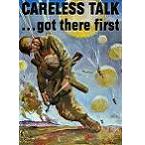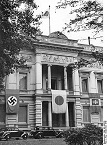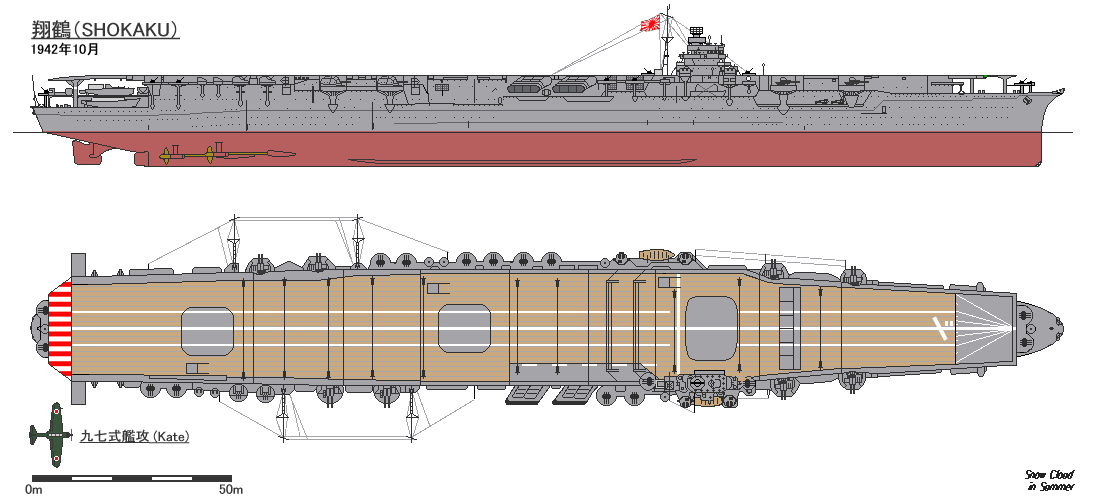Local Yokel
Posts: 1494
Joined: 2/4/2007
From: Somerset, U.K.
Status: offline

|
Some support for Dallas Isom’s contention that Akagi took a reduced aircraft complement to Hawaii is to be found in the War History aircrew roster, to which I referred earlier. If correct, it reveals that Akagi despatched 33 aircraft in the first attack wave, and only 27 in the second. On the Isom figures that would leave 7 fighters for CAP over Kido Butai.
Morinaga’s recollection that Akagi was carrying extra fuel in the lower hangar is tantalising because it begs the question ‘which lower hangar?’ Did he mean the second level hangar or the third? The third hangar was very much smaller than the other two, but the most likely place for storage of additional fuel drums.
This leads conveniently to consideration of the Japanese carriers’ hangar area. Referring to Parshall and Tully’s Shattered Sword, Akagi is credited with 93,000 square feet for the upper and middle level hangars combined, and 8,515 square feet for the lower level hangar. For Kaga, the corresponding figures are 108,240 square feet and 5,568 square feet. Hiryu and Soryu had only two hangar levels; they lacked the small third level hangar of the bigger carriers. Parshall and Tully credit both Hiryu and Soryu with same overall hangar area: 61,740 square feet.
There’s no getting away from this: Hiryu and Soryu had only 66% of the hangar area of Akagi and 57% of that of Kaga – and that’s leaving out of account the additional space of the two big carriers’ third level hangar. Akagi’s hangar area was approximately 86% of that for Kaga. Yet, according to the capacity figures attributed to the carriers in the game, Kaga can accommodate only 72 aircraft against Akagi’s 81, notwithstanding her significantly larger hangars. Meanwhile Hiryu, with a hangar area only two thirds the size of Kaga, can accommodate only one fewer aircraft.
The number of aircraft in a deckload spot may be all very well as a measure of a carrier’s striking capacity, but overall capacity and the limit it places on total aircraft embarked has greater relevance to that ship’s ability to remain in a fight once attrition has started to take its toll. In the CHS version of WitP, Shokaku, Zuikaku, Kaga and Akagi were each given a capacity of 84 aircraft, whilst Hiryu and Soryu had capacities of 71 and 70 respectively. In AE these have been altered as follows:
Hiryu: no change
Akagi: -3
Soryu: -7
Kaga, Shokaku and Zuikaku: -12
It appears that something prompted the developers to make these reductions, but I can see no obvious rationale for them. In particular, it makes no sense to me that Hiryu, with only two-thirds of Kaga’s hangar area, should be treated as having substantially the same capacity. Even more inexplicable is a decision that Kaga, with bigger hangars than Akagi, should have her capacity reduced by four times the amount of Akagi’s reduction.
I would welcome an explanation of these reductions, and also one about the impact, if any, of reserve aircraft upon a carrier’s capacity.
<edit> Corrected spelling </edit>
< Message edited by Local Yokel -- 11/14/2010 11:37:02 AM >
_____________________________
|
 Printable Version
Printable Version



















 New Messages
New Messages No New Messages
No New Messages Hot Topic w/ New Messages
Hot Topic w/ New Messages Hot Topic w/o New Messages
Hot Topic w/o New Messages Locked w/ New Messages
Locked w/ New Messages Locked w/o New Messages
Locked w/o New Messages Post New Thread
Post New Thread